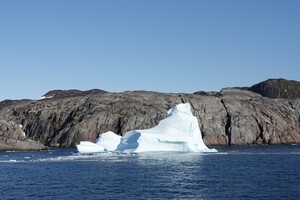Scientists believe that this could cause extreme weather events in the United States and Europe.

New data point to incredibly high Arctic warming , in some regions it is seven times faster than worldwide. Warming is occurring in the north of the Barents Sea, a region whose high temperatures are thought to exacerbate extreme weather events in North America, Europe and Asia, according to The Guardian.
Scientists believe that what is happening in the Barents Sea may be a “sketch” of what will happen in the rest of the Arctic.
Read also: Siberian tundra may disappear due to global warming
>
New data show that the average temperature here rises by 2.7 degrees Celsius per decade. It grows especially fast in autumn, when the average values increase by four degrees in 10 years. This makes the Barents Sea and its islands a warmer region than anywhere else on Earth.
Unprecedented high temperatures have been recorded in the Arctic in recent years, with observers calling the situation “shocking”, “crazy” and “strange”. Some climatologists have warned that such high temperatures could indicate a faster and sharper climate breakdown.
It was already known that the climate crisis had caused the Arctic to heat up three times faster than other parts of the world. But new research shows that in some places the situation is much more extreme.
Sea ice reflects sunlight well, but it melts. This allows the ocean beneath it to absorb more energy. The loss of ice allows warm seawater to heat Arctic air. The more ice is lost, the more heat accumulates and a feedback loop is formed.
The researchers' research is based on data from automatic meteorological stations located on the islands of Svalbard and Franz Josef Land. Researchers analyzed temperatures in the region between 1981 and 2020.
“Regional warming rates for the northern Barents Sea are exceptional, 2 to 2.5 times higher than the Arctic average and 5-7 times higher than the global warming average,” the researchers said. p>”We expected to see strong warming, but not on the scale we found. We were all surprised. From what we know from all other observation points on the globe, this is the highest rate of warming we have seen so far, “said Kathil Isaksen, senior researcher at the Norwegian Meteorological Institute. added that in a broader sense, the new data suggest that the feedback loop is much wider than previously thought. Isaksen also emphasizes that the processes observed in the Barents Sea are an illustration of what could happen in other parts of the Arctic if the ice continues to melt.
“This study shows that even the best possible models underestimate the rate of warming in the Barents Sea. We seem to be watching it move to a new regime, as it is less like the Arctic and more like the North Atlantic. Now the situation is really on the verge, and it is unlikely that sea ice will persist in the region much longer, “said Ruth Mottram, a climatologist at the Danish Meteorological Institute who did not participate in the study.
conducted a study that showed that rains will soon replace snowfall as the most common type of Arctic precipitation . This will happen due to climate change and the warming of the polar region of our planet.
See special topic: Siberian tundra may disappear due to global warming As temperatures rise forests will occupy the northern territories. The snow-capped Alps are turning green and the changes are already visible from space This is due to global warming. Eating insects can help cope with climate change: how it is possible Scientists call insects an important source of protein. Davos 2022: “Green Transition” and digitalization will define the labor market of the future At the same time, “traditional spheres” of the economy remain equally important. WMO has made a disappointing forecast for global warming The chances that temperatures on the planet will be 1.5 degrees above pre-industrial levels have increased.




